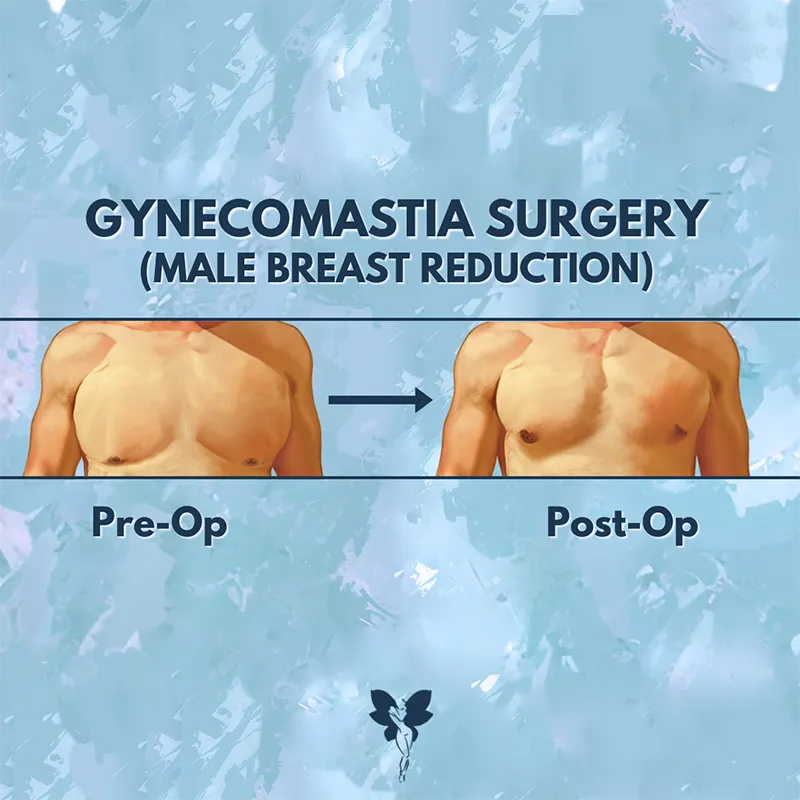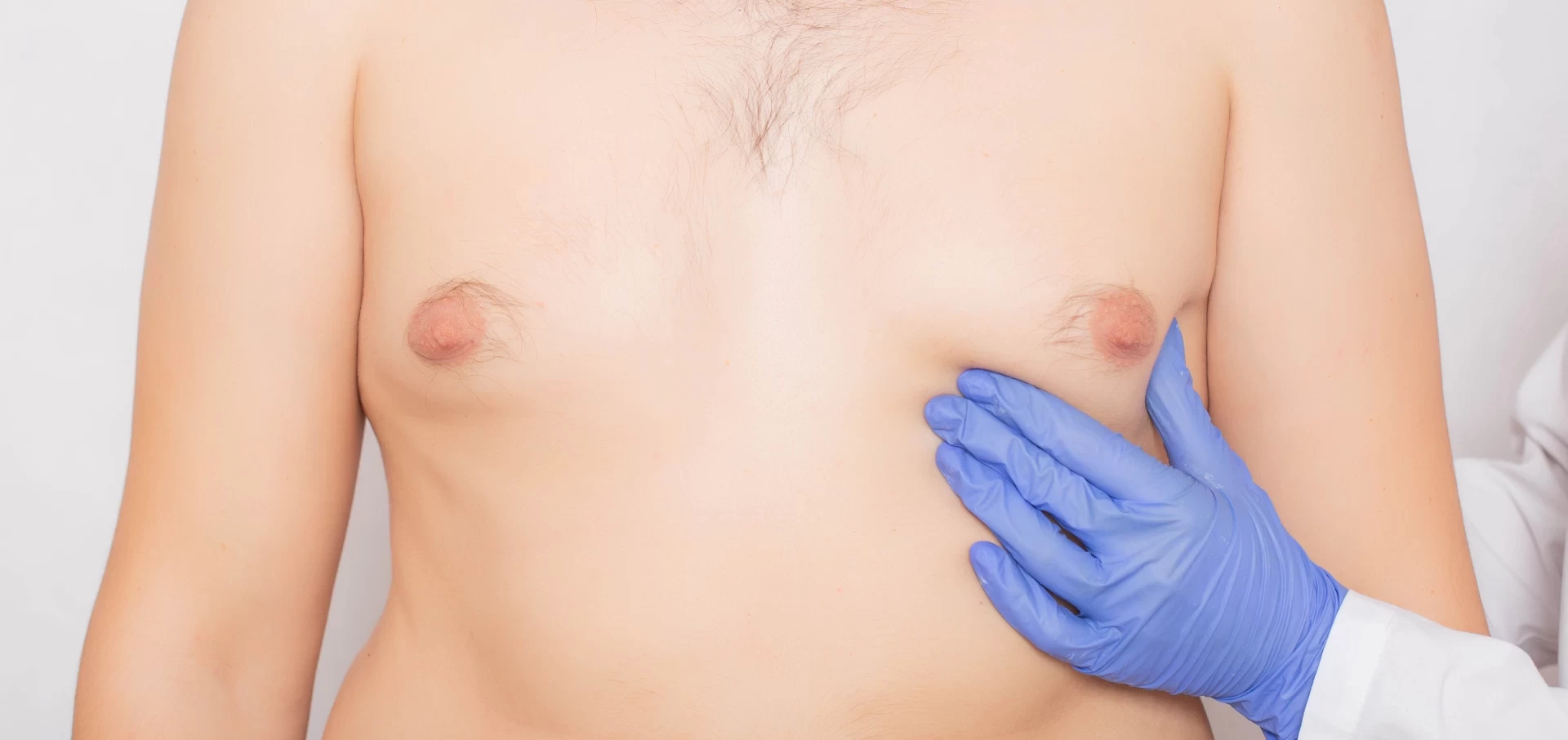Gynecomastia is the medical term for an abnormal enlargement or swelling of breast tissue in men. The so-called "male breast enlargement" is the result of an increase in the mammary gland and the accumulation of fat in the breast tissue. Gynecomastia can develop due to physiological or pathological causes. It can be seen throughout life starting from adolescence. The answer to the question of what gynecomastia is can be given in this way.
During puberty, hormonal changes can lead to gynecomastia. Especially in adolescent boys, breast tissue may temporarily enlarge due to imbalances between oestrogen and testosterone levels. This condition is considered part of the physical development of young men. It resolves spontaneously within a few months or years. Gynecomastia usually develops symmetrically in both breasts. Mild swelling or tenderness may be seen in the nipple.
The main causes of gynecomastia may include hormonal changes, drug use, obesity, aging process, and in rare cases, underlying medical problems. The question of how to understand gynecomastia arises at this point. Hormonal changes during puberty can lead to gynecomastia in men. Oestrogen and testosterone levels change rapidly during this period. At the same time, the balance may be disturbed. In particular, an increase in the hormone oestrogen can cause breast tissue to grow. When puberty ends, the hormonal imbalance is corrected. Gynecomastia can also go away on its own without surgery.
Some medications can increase the risk of gynecomastia. Anti-androgen drugs, anabolic steroids, some antidepressants, stomach ulcer medications and some drugs used to treat cancer can cause breast tissue to grow. These drugs can affect hormone levels and cause abnormal growth of breast tissue. In case of gynecomastia due to drug use, different treatment options may need to be evaluated by correcting the dose of the drugs. Along with the answer to the question of what gynecomastia means, you should also investigate the cause.

An increase in body fat tissue can increase estrogen production. Accordingly, it can lead to the growth of breast tissue. Obesity can cause fat accumulation, especially in areas that are prone to breast tissue growth. This can increase the risk of gynecomastia. Adopting a healthy lifestyle, controlling weight and exercising regularly can reduce the risk of gynecomastia associated with obesity. The use of a gynecomastia brace may be recommended.
The aging process can lead to hormonal changes and changes in body composition. Testosterone levels may decrease with age, while estrogen levels may remain stable or increase. This hormonal imbalance can lead to gynecomastia in older men. In addition, changes in body fat distribution can occur with the aging process.
In rare cases, gynecomastia can be a symptom of underlying medical problems. Health problems such as problems with the testicles or adrenal glands, liver and kidney disease can lead to hormonal imbalances. This can cause breast tissue to grow. In such cases, treating the underlying health problem can correct gynecomastia. Thus, the answer to the question of why gynecomastia occurs can be given.
Symptoms of gynecomastia can manifest in various ways. The most common symptom is swelling or enlargement of the breast tissue. One or both breast tissues may be swollen with noticeable enlargement. The nipples may be tender. The growth of breast tissue can often cause pain and tenderness. These are the basic details of the symptoms of gynecomastia.
Changes in breast shape may occur with breast enlargement. The nipples may protrude in a different direction or there may be asymmetry in the overall shape of the breast tissue. Skin discoloration or wrinkles around the nipple may be noticeable. Although gynecomastia does not increase a man's risk of breast cancer, it is important to check for changes in breast tissue to rule out more serious problems such as breast cancer.
There are various causes of gynecomastia. The most common causes are hormonal changes. Especially for men during puberty, hormonal fluctuations can lead to gynecomastia. However, aging, hormonal imbalances, obesity, liver and kidney diseases, medications and some medical conditions can also cause gynecomastia. These details are among the symptoms of gynecomastia.
Gynecomastia is diagnosed by a doctor based on a physical examination and the patient's medical history. In some cases, imaging tests may be needed to test hormone levels. Treatment differs depending on the underlying causes of gynecomastia. While gynecomastia due to hormonal changes resolves spontaneously, if there are underlying medical causes, treatment for these causes may be required. It is important to benefit from gynecomastia treatment. In severe cases or in cases of significant psychological disturbance, surgical intervention may be considered. Gynecomastia treatment can give successful results.
Breast tissue enlargement, pain or tenderness, shape changes, changes in the nipple can be detected by self-examination. The causes of gynecomastia may include hormonal changes, aging, obesity, medications and medical conditions. Treatment varies depending on the underlying causes. It should also be done under the supervision of a doctor.

Click to view Before - After photos
Gynecomastia can occur at different periods of life but is most common during puberty. Puberty usually starts between the ages of 9 and 14. It continues until the average age of 16-17. Hormonal changes occur in the body. Hormones such as oestrogen and testosterone can fluctuate. Hormone imbalances can cause breast tissue to grow.
In addition to puberty, gynecomastia can occur in different age groups. For example, in older men, hormonal changes and a decrease in testosterone levels can lead to gynecomastia. Factors such as certain health conditions, medications or excessive alcohol consumption can also contribute to gynecomastia.
Gynecomastia is not a condition confined to a certain age range. It can occur at different periods of life. If gynecomastia is of alarming proportions or is causing pain, it is important to consult a health professional. The doctor will assess the patient's health history, perform a physical examination and order additional tests if necessary. Treatment methods may vary depending on the cause of gynecomastia. Sometimes it may only need to be followed up.
Before starting gynecomastia treatment, your doctor may perform a series of tests and evaluations to determine the underlying cause. Several factors can cause gynecomastia, such as hormonal imbalances, medication use, medical conditions or aging. It is important to identify the underlying cause to create the right treatment plan.
Once the cause of gynecomastia is determined, the treatment plan is shaped accordingly. For example, gynecomastia caused by hormonal imbalances can be corrected with hormonal treatment with medications, while in case of gynecomastia caused by medications, discontinuation with medication changes may be considered. The pituitary gland, which is treatable, acts on fat tissue.
In some cases, lifestyle changes can help treat gynecomastia. In particular, if obesity has caused gynecomastia, weight loss and regular exercise may help to improve the condition. Surgical intervention may be required in some cases of gynecomastia. Especially in cases of prolonged and prominent gynecomastia, excess breast tissue can be removed. The surgical procedure can be performed as liposuction or mastectomy.
Gynecomastia can cause self-confidence and body image problems in men. It is important to provide psychological support during the treatment process. Counselling or support groups can help the patient to better manage the process. Regular medical check-ups should be done during gynecomastia treatment. Check-ups are important to evaluate the effectiveness of the treatment and adjust the treatment plan if necessary.
Medications can be used to treat gynecomastia. However, medicines may have side effects. The doctor's instructions should be strictly followed and information about possible side effects should be obtained. During gynecomastia treatment, it is important to learn about the risk factors that may occur depending on the underlying causes and to take precautions against the factors. For example, maintaining a balanced lifestyle during hormone therapy or taking care of wound care after the surgical procedure.
The recovery process after gynecomastia surgery may vary depending on the patient's health condition, the type of surgery and personal factors. During the first few days after the surgery, mild pain, swelling and bruising may be seen. This is a normal reaction and decreases within a few days. Your doctor may recommend prescribed medication to control postoperative pain. In the first days after surgery, it may be recommended to take care to rest, keep your head elevated while lying down, and sleep on your back while lying down.
Your doctor will inform when these stitches will be removed. You may also need to wear bandages or special clothing. These garments can help reduce swelling and promote proper healing of breast tissue after surgery. Gynecomastia in men is a common condition.
It is recommended to avoid heavy physical activity for the first few weeks after surgery. Avoiding exercise during the period when postoperative swelling and bruising are at their peak can speed up the healing process. You can start moving slowly in accordance with your doctor's instructions.
The recovery time may vary from person to person. Patients can return to normal daily activities within a few weeks. However, full recovery may take longer. If it is necessary to take gynecomastia medication, it should not be interrupted. It is important to get your doctor's approval to return to activities such as increasing physical activity, heavy lifting or playing sports. Gynecomastia should be followed carefully before and after.
As the process continues, swelling and bruising gradually decrease. The results usually start to become evident within a few weeks after surgery. However, it may take several months for full results to appear. During the healing process, it is important to have regular check-ups with your doctor, monitor your health and take necessary precautions. Gynecomastia surgery is a safe procedure, but as with any surgical procedure, there are risks. Risks such as infection, wound healing problems or complications due to anaesthesia are minimal, but you should talk to your doctor about these possibilities. Gynecomastia surgery prices may vary depending on the type of procedure.
Nutrition and adequate hydration are important after gynecomastia surgery. Adhering to a healthy eating plan can support the healing process. Adequate protein intake can help the body heal by repairing tissues. At the same time, eating fruits and vegetables rich in antioxidants can reduce the risk of inflammation after surgery. Drinking plenty of water also helps hydrate and detoxify the body. Following the dietary guidelines recommended by your doctor can speed up recovery after surgery.
The recovery process after surgery can be made more effective if the patient behaves in accordance with the doctor's instructions. Information should be obtained from the doctor for gynecomastia athlete and other details. It is important to contact your doctor whenever you have any questions or concerns. You can act according to your budget by researching gynecomastia price options in detail.